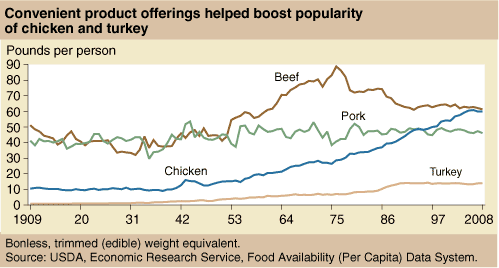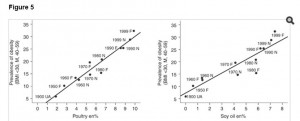Chicken is the most popular meat in the United States; in 2010, 8.6 billion chickens were killed to provide Americans with 37.2 billion pounds of chicken, compared to 26.4 billion pounds of beef, 22.5 billlion pounds of pork, 5.8 billion pounds of turkey, and only 0.3 billion pounds of veal, lamb, and mutton.
The popularity of chicken has grown steadily over the last century. Here is a chart from the USDA Economic Research Service:
Increasing chicken consumption followed the development of cheaper chickens in the 1940s, which led to greater use of chicken into prepared and fast foods. It was further encouraged in the 1970s by the widely promulgated idea that red meat might be unhealthful and that chickens were comparatively healthful.
Yet in fact chicken may be the least healthful of the popular meats!
In our book (p 171) we give industrially raised chickens and their eggs a grade of C, eggs and meat from organically raised heritage chickens a B+/B. By comparison, beef gets an A. Why the difference?
Unhealthy Chickens
The methods that created cheaper chicken meat do not produce healthy chickens. Chickens were bred for rapid growth, but the modern Cornish Rock hens develop arthritis around age ten weeks, are often infertile, and prefer not to walk. (See “Local Farming and The Fight for Quality Food,” October 25, 2011.)
Factory farmed chickens are also fed arsenic, antibiotics, antihistamines, and, in China, antidepressants. [1] [2] (See Chapter 23 of the book.) It has recently been realized that these compounds may remain present at low levels in chicken meat. UPDATE: In the comments, Rachel Virden points out flaws in the studies cited above; chicken meat may be more healthful than these studies would suggest.
Omega-6 Fats and Obesity
Chicken have a moderately high omega-6 content; a whole chicken provides about 13% of all calories (about 20% of fat calories) as omega-6 fats. Because omega-6 toxicity begins at about 4% of energy (see chapter 11 of the book), replacing low-omega-6 foods like beef and seafood with chicken can help generate toxic levels of omega-6 in the body.
This has a variety of unfortunate consequences, including obesity. In my recent Q&A with Latest in Paleo readers, I gave six reasons why omega-6 fats promote weight gain. The last reason was that “omega-6 fats are precursors to endocannibinoids which increase appetite (see this article).”
The article in question shows an interesting figure which notes that chicken consumption is, after vegetable oils and with pork, the major contributor of omega-6 fats to the American diet, and is correlated with obesity prevalence (Figure 5):
Omega-6 Fats and Cancer
Omega-6 fats promote cancer growth and metastasis, and so we might expect that chicken consumption will also promote cancer.
It may. A study of men in remission from prostate cancer found that, “Intakes of processed and unprocessed red meat, fish, … and skinless poultry were not associated with prostate cancer recurrence or progression.” [3] However, the fatty parts of chickens – the skin and the eggs – were:
Greater consumption of eggs and poultry with skin was associated with 2-fold increases in risk in a comparison of extreme quantiles: eggs [hazard ratio (HR): 2.02; 95% CI: 1.10, 3.72; P for trend = 0.05] and poultry with skin (HR: 2.26; 95% CI: 1.36, 3.76; P for trend = 0.003)…. Men with high prognostic risk and a high poultry intake had a 4-fold increased risk of recurrence or progression compared with men with low/intermediate prognostic risk and a low poultry intake (P for interaction = 0.003).
Our results suggest that the postdiagnostic consumption of processed or unprocessed red meat, fish, or skinless poultry is not associated with prostate cancer recurrence or progression, whereas consumption of eggs and poultry with skin may increase the risk. [3]
We recommend three egg yolks per day for their nutrition, but the poor quality of industrial chickens is a real concern. If you can find a place in your budget for only one naturally raised food, make it your eggs.
Badly Cooked Chicken
Much chicken is bought in industrially produced forms or as fried chicken cooked in vegetable oils at high temperatures. High temperatures and peroxidizable vegetable oils are not a good way to treat any meat; as we note in the book (Chap 23), harsh cooking methods increase the toxicity of foods.
It seems to work that way with chicken. Another cancer study found that fried chicken consumption was associated with higher prostate cancer risk. They write:
Potential mechanisms include the formation of potentially carcinogenic agents such as aldehydes, acrolein, heterocyclic amines, polycyclic aromatic hydrocarbons, and acrylamide. [4]
Conclusion
I think most of the health problems with chicken are probably attributable to its omega-6 content, and in the context of a low omega-6 diet there is probably little harm to consuming gently cooked chicken or eggs. So I think most of the known concerns with chicken consumption should not frighten Perfect Health Dieters. Ironically, what makes chicken healthful is consuming red meat or seafood most of the week!
However, because eggs are such a significant part of our micronutrient recommendations, I think it is desirable to find an egg producer who lets the hens roam and eat insects and other natural chicken foods. Healthy chickens produce more healthful eggs; healthful eggs produce healthy people.
References
[1] Nachman KE et al. Arsenic species in poultry feather meal. Science of the Total Environment 2012 Feb 15;417–418:183–8, http://pmid.us/2224435.
[2] Love DC et al. Feather meal: a previously unrecognized route for reentry into the food supply of multiple pharmaceuticals and personal care products (PPCPs). Environmental Science & Technology 2012 Apr 3;46(7):3795–802, http://pmid.us/2243597.
[3] Richman EL et al. Intakes of meat, fish, poultry, and eggs and risk of prostate cancer progression. Am J Clin Nutr. 2010 Mar;91(3):712-21. http://pmid.us/20042525.
[4] Stott-Miller M et al. Consumption of deep-fried foods and risk of prostate cancer. Prostate. 2013 Jan 17. doi: 10.1002/pros.22643. [Epub ahead of print] http://pmid.us/23335051.













Recent Comments